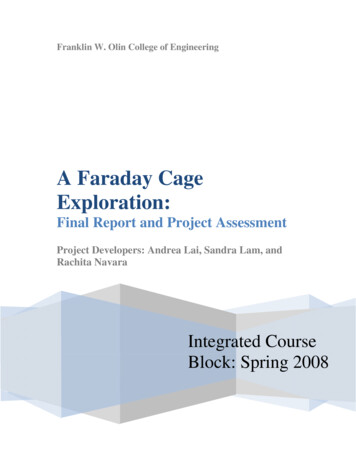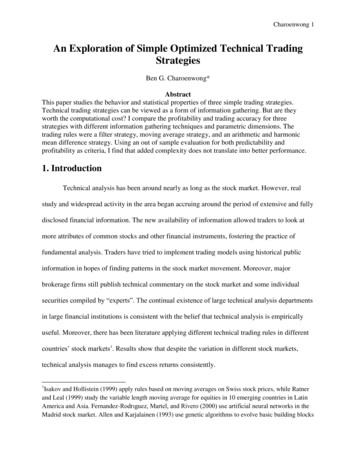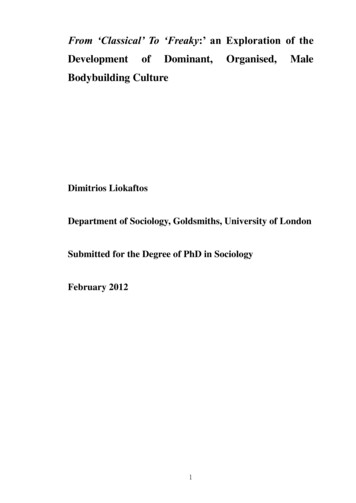
Transcription
Franklin W. Olin College of EngineeringA Faraday CageExploration:Final Report and Project AssessmentProject Developers: Andrea Lai, Sandra Lam, andRachita NavaraIntegrated CourseBlock: Spring 2008
Introduction: Why Faraday cages?In this project, we developed a hands-on activity and related demonstrations that focus onthe shielding property of Faraday cages, which are metal enclosures that can block outelectromagnetic waves. Faraday cages are valuable tools for explaining electricity andmagnetism to students because they produce intriguing, easily observable phenomena whileapplying an understanding of various physics concepts. Students can test electromagneticshielding in a fun and simple manner by placing a communication device inside a conductingcontainer, closing the lid, and observing whether the device is immediately silenced. The ease ofmaking and testing Faraday cages with easily obtainable materials is conducive to the classroomatmosphere for which this project was designed. The cage system can also accommodate furthercomplexity, given that varying conducting wall thickness and continuity will affect shieldingperformance.Moreover, the Faraday shielding effect often emerges in real-world scenarios. Anunderstanding of these cages can elucidate several fascinating concepts, from why cell phonereception is so weak in elevators, to how high-security organizations use metal rooms to preventelectronic espionage [1]. The various manifestations of electromagnetic shielding offer studentsopportunities to explain natural phenomena with their own scientific knowledge. This promptsstudents to adopt a self-motivated, inquisitive mindset that can extend through their educationalcareer and beyond.Project Goals and ObjectivesAn underlying goal of our project was to further our own understanding of electricity,conductor behavior, and electromagnetic waves. To attain a deeper comprehension of thesetopics, we qualitatively and quantitatively analyzed Faraday cage behavior and developedexplanations for cage performance in response to different electromagnetic signal frequencies.We were then able to compose a scientific exploration for middle school students that revealsand justifies these differences in Faraday cage effectiveness. The step-by-step testing and“learning by doing” approaches in our hands-on activity encourage students to explain forthemselves why different cages produce different results.According to Massachusetts curriculum standards, students are not exposed to the topicof electromagnetic waves until high school introductory physics [2]. However, we sought tointroduce the concepts of electricity and magnetism to students before high school. Because theabstract concepts of electromagnetism may be intimidating to students when first encountered,
our activity aims to provide familiarity with the topics in an interactive setting before studentscan develop a mentality that “physics is hard” [3]. For instance, we preface our explanation ofelectromagnetic waves by demonstrating wave propagation in a mechanical model such as aSlinky. In this way, students are also engaged to learn advanced science topics within the contextof real-world applications.Specific Pedagogical ApproachesThe broader impact of our work lies in the pedagogical approaches we incorporated inour hands-on activity. By encouraging middle-school students to rationalize complex physicsphenomena through an exciting, applicable investigation of Faraday cages, we can instill a selfmotivation to explore science creatively.While developing this activity, we consulted several pedagogical resources that mirrorour project intentions. In particular, the publication, “Learning Electromagnetism withVisualizations and Active Learning” addresses the specific physics content we will explore withour demonstration [4]. The paper focuses on learning electromagnetism with an emphasis on“concrete and visual representations in teaching abstract concepts.” Accordingly, our mechanicalwave demonstrations and simple analogies are aimed to give students the clearest explanations ofabstract topics, about which they may have minimal background knowledge. These analogieswill be especially valuable for students performing this activity, given that similar instructivemodels have been proven successful in a study that tested the effectiveness of teachingelectromagnetism by analogy [5].Content to FollowTo further our own learning and student understanding, we have prepared backgroundmaterials that are appropriate for our middle school audience. This set of readings includesstudent-friendly introductions to electricity and wave motion. Prior to the in-class activity,teachers may assign one or both of these materials for students to read, as they see fit. Thesestudent introductory reading materials begin on the next page of this report, followed by aninstructor copy of our hands-on activity procedure. Appendix A of this document contains anactivity sheet hand-out for students. Next, Appendix B includes a companion lesson to ouractivity, which illustrates wave motion as applicable to Faraday cage electromagnetic shielding.Appendix B includes a wave lesson that supplements our activity. Finally, the advanced physicscontent we explored while developing this activity is included in Appendix C.
Introductory Reading, part IElectricity and ConductorsHave you ever experienced an electric shock after walking across a carpet and touching adoorknob?Has anyone told you that the safest place during a lightning storm is inside your car?Do you know why cell phone reception is so weak inside an elevator?All of these puzzling concepts can be explained by electricity, and its behavior within metals.Let’s begin with the first topic: the painful shocks that result from static electricity, a build-upof electric charge. The atoms that make up some materials hold onto their electrons strongly thanthose in other materials. When dissimilar materials such as wool and plastic are rubbed againsteach other, electrons are pulled from one material and taken up by the other [1]. As a result, onematerial becomes more negatively charged because it gains more electrons, while the otherbecomes more positively charged because it loses electrons. Consider the carpet-sock example:when you drag your feet along the carpet, you pick up extra electrons from the floor, giving youa negative charge. Then, when you touch a metal doorknob, the electrons jump from your handto the doorknob so that both objects can share the same charge. These free electrons will travelthrough the air in an electron “river,” forming a visible spark [2].The speed with which your electric charge is transferred to the doorknob demonstrates theproperties of a conductor, any material that promotes the flow of electricity. Poor conductors (orinsulators) restrict the flow of electricity. Metals are especially good conductors because atomsin a metal do not hold tightly to their electrons [3]. Because these electrons can move freelywithin the metal, they can transfer, or conduct electricity very quickly.This leads us to our second question: why would you be protected from lightning when sittinginside a car? Might it be because the car has rubber tires, and rubber insulates objects fromelectric charge? In truth, the rubber offers no protection from a lightning strike, which is simply ahigh-energy electric spark much like the one you feel when touching a doorknob. When youthink about it, lightning can travel through the air—a relatively good insulator. If air cannotprotect people from lightning, a few inches of rubber certainly can’t shelter the occupants of acar from a lightning bolt. So what’s the real reason that cars are safe during a lightning storm?The answer lies in the behavior of conductors in response to electric fields.Electric FieldsLet’s consider a rotten egg placed in the corner of a room. You can imagine how smelly theroom would become, and your nose would soon detect the presence of the egg. Essentially, theegg has produced a “stinky field” within the area. As you move toward the rotten egg, you areaffected by the stinky field more and more strongly. We can think of an electric charge like arotten egg because every charge produces an electric field that affects other charged objectswithin it (similar to the way noses are affected by a stinky field) [5,6].In our stinky field analogy, we wouldn’t willingly approach the rotten egg, but electric charges infields don’t always move away from the source of the field. Have you ever heard the phrase,
“Opposites attract; likes repel”? This applies to electric charges! If both objects share the samesign charge, the objects repel. If both objects are oppositely charged, they attract each other, sothe charged object will move toward the source of the electric field. Note that charges don’t haveto come in contact to affect each other; the attractive or repulsive force between charges actsacross the distance between them. This is why electric force is often termed an “action-at-adistance force,” exerted by an electric field on other electrically-charged objects [7].It may be difficult to understand this concept, but other familiar forces actat a distance. An excellent example is Earth’s gravitational field. Whathappens when you hold an apple in the air and let go of it? Just as IsaacNewton observed centuries ago, it falls to the ground. Of course, theattractive force that the earth exerts on the apple is invisible—just likeattractive and repulsive electric forces. Action-at-a-distance forces alsoapply to magnets. If you have ever played with two magnets, you knowthat holding them apart in a certain orientation causes them to snaptogether, while they refuse to come together when you flip one magnet[5]over. Just like with electrically charged objects, opposite magnetic polesattract, and like poles repel. Further, the magnets only respond to each other when they are closetogether, revealing the presence of magnetic fields.Faraday Cage ShieldingNow that we understand electric fields, we can fully explain why cars can protect you fromlightning. Recall that electrons can move very quickly inside a conductor, and that lightning ismade up of many electrons. So let’s examine how a conductor behaves in response to an externalelectric field. Consider a conductor that is negatively charged, or contains excess electrons (-).These “extra” electrons repel each other because they are of the same sign. Thus, they try to getas far away from each other as they can. In order to do this, they arrange themselves on theoutside surface of the conductor, which ultimately causes the electric field inside the conductorto be cancelled [8]. Imagine ten of your classmates stuffed inside an elevator after soccer practice.Everyone would smell sweaty and try to move as far apart as possible. This would be bestachieved if everyone pressed themselves against elevator walls—just as electrons redistributethemselves along the outside surface of a conductor.So what happens when lightning strikes a metal car? Due to the electric field created by thelightning strike, electrons within the metal car body will redistribute along the outer surface ofthe car. It turns out that this electron redistribution cancels the electric field inside the car. Thisprocess is known as electrostatic shielding (electrostatic the electric charges aren’t moving).Thus, because Faraday cages contain regions of zero electric field, people are protected from alightning storm within metal enclosures, such as cars and steel-framed buildings [9].Now that you understand that Faraday cages have no internal electric fields, you can move on toPart II of this reading to discover how cages can block waves such as radio signals.
Part I Introductory Reading References:1. Pilkington, G.A. “Static electricity-friend or foe.” Electrical Safety in HazardousEnvironments, 1994. Fifth International Conference on Electrical Safety in HazardousEnvironments, 19-21 (1994): 63- 68.2. “Static Electricity & Static Control.” 2008. ElectroStatics, Inc. 18 Apr. 2008 http://www.electrostatics.com/page2.html .3. Voltmer, D.R., "Transient response of good conductors." Proceedings of the IEEE, 63, 2(1975): 318-319.4. Murphy, Tom. “Faraday Cages and Microwaves.” UCSD: Physics 8; 2006. 16 Apr. 2008 http://physics.ucsd.edu/ tmurphy/phys8/lectures/14 microwave.ppt .5. Henderson, Tom. “Lesson 4: Electric Fields.” The Physics Classroom Tutorial. 2007. 18Apr. 2008 statics/u8l4a.html .6. “Electric field.” Encyclopaedia Britannica. Electronic ed., version 1.0. 2005.7. Crowell, Benjamin. “10.1.3: The Electric Field.” Simple Nature. Vol. 2. CreativeCommons, 2007. 483-490.8. Duffy, Andrew. “Electric Field.” Boston University: PY106 Elementary Physics II coursenotes. 2000. 18 Apr. 2008 http://physics.bu.edu/ duffy/PY106/Electricfield.html .9. Centre for Earth Science Studies. Lightning: Phenomenon & Precautions. ThiruvanAnthapuram, 2002.10. Kaiser, Kenneth. Electromagnetic Compatibility Handbook. Boca Raton: CRC Press,2005. 24-75.11. Crowell, Benjamin. “Chapter 11: Electromagnetism.” Simple Nature. Vol. 2. CreativeCommons, 2007. 571-578.12. Malyapa, R.S. et al. 1997. “Measurement of DNA damage after exposure toelectromagnetic radiation in the cellular phone communication frequency band (835.62and 847.74 MHz).” Radiat. Res. 148, pp. 618–627.
Introductory Reading, part IIPhysical WavesFrom Part I of this reading, we discovered how a Faraday cage can cancel the electric field insideit, but how does a Faraday cage behave in the presence of waves? To begin, let us look at thedifferent properties of visible waves.Have you ever observed the motion of ocean waves? What about ripples that form when youdrop a stone in a lake? At first, waves only appear where the stone was dropped. However, astime passes, these waves circle further and further out from their center.ht
A Faraday Cage Exploration: Final Report and Project Assessment Project Developers: Andrea Lai, Sandra Lam, and Rachita Navara. Introduction: Why Faraday cages? In this project, we developed a hands-on activity and related demonstrations that focus on the shielding property of Faraday cages, which are metal enclosures that can block out electromagnetic waves. Faraday cages are valuable











